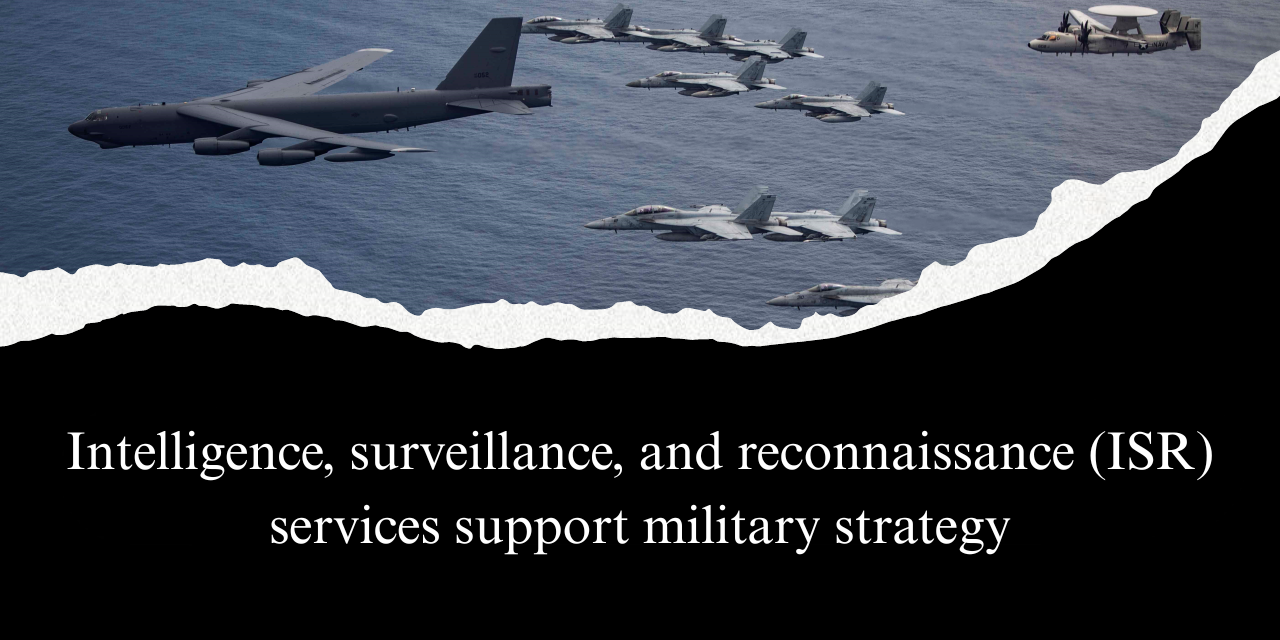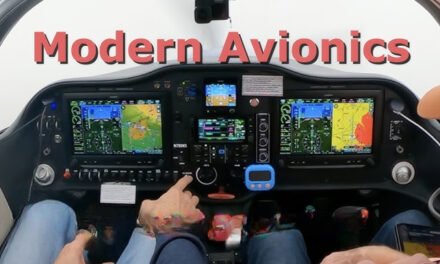Intelligence, Surveillance, and Reconnaissance (ISR) services are essential to modern military strategy, providing timely, accurate, and actionable information that informs decision-making, enhances situational awareness, and supports mission success. By collecting and analyzing data across multiple domains—land, air, sea, space, and cyber—ISR services enable military forces to maintain a strategic advantage in both peacetime and conflict. Here’s how ISR supports military strategy:
1. Enhancing Situational Awareness
A. Real-Time Data Collection
- Role: Gather intelligence about the operational environment, including enemy positions, movements, and capabilities.
- How It Works:
- Sensors on satellites, aircraft, drones, and ground systems capture imagery, signals, and other data.
- Example: High-altitude drones like the Global Hawk provide real-time imagery of enemy terrain.
B. Comprehensive Domain Coverage
- Role: Monitor activities across multiple domains for a holistic operational picture.
- How It Works:
- Space-based assets monitor missile launches; naval systems track underwater threats; airborne platforms observe troop movements.
- Example: The Aegis Combat System integrates radar and sensor data for maritime situational awareness.
2. Supporting Strategic Decision-Making
A. Threat Assessment
- Role: Identify potential threats and assess their intent and capability.
- How It Works:
- Signals intelligence (SIGINT) intercepts enemy communications; human intelligence (HUMINT) gathers field-level insights.
- Example: SIGINT systems identify electronic signatures of hostile radar systems.
B. Predictive Analysis
- Role: Anticipate enemy actions and plan countermeasures.
- How It Works:
- Artificial intelligence (AI) analyzes historical data and patterns to forecast adversary behavior.
- Example: Predictive algorithms in ISR systems highlight likely enemy troop movements.
3. Supporting Mission Planning and Execution
A. Target Identification and Tracking
- Role: Pinpoint and monitor high-value targets.
- How It Works:
- Geospatial intelligence (GEOINT) and electro-optical systems provide precise target coordinates.
- Example: Drones like the MQ-9 Reaper track moving vehicles or individuals in contested regions.
B. Precision Engagement
- Role: Enable accurate strikes by providing detailed target data.
- How It Works:
- Laser designators and GPS-guided systems integrate ISR inputs for precision targeting.
- Example: ISR data ensures guided munitions hit their targets with minimal collateral damage.
4. Force Protection
A. Early Warning Systems
- Role: Alert forces to imminent threats, such as missile launches or ambushes.
- How It Works:
- Radar and infrared systems detect incoming threats, while drones monitor enemy activity near bases.
- Example: Space-based infrared systems (SBIRS) detect ballistic missile launches early.
B. Counter-IED Operations
- Role: Identify and neutralize improvised explosive devices (IEDs).
- How It Works:
- ISR platforms scan routes for suspicious objects or movements.
- Example: Tactical drones survey convoy paths to detect roadside bombs.
5. Enabling Multi-Domain Operations
A. Integration Across Forces
- Role: Facilitate seamless coordination among land, air, sea, and space forces.
- How It Works:
- ISR systems share data across platforms to ensure synchronized actions.
- Example: The Joint Surveillance Target Attack Radar System (JSTARS) integrates ground and air intelligence for joint operations.
B. Cyber ISR
- Role: Monitor and secure military networks while identifying enemy cyber activities.
- How It Works:
- Cybersecurity teams use ISR to track adversary malware, phishing attempts, and network vulnerabilities.
- Example: Detecting and countering cyberattacks targeting command-and-control systems.
6. Supporting Counterterrorism and Irregular Warfare
A. Tracking Insurgents and Terrorists
- Role: Monitor and disrupt activities of non-state actors.
- How It Works:
- ISR drones track insurgents, while SIGINT intercepts communications for actionable intelligence.
- Example: UAV surveillance identifies terrorist hideouts in remote regions.
B. Monitoring Supply Chains
- Role: Disrupt illegal arms or resource movements.
- How It Works:
- Maritime and aerial ISR platforms monitor shipping lanes and border crossings.
- Example: Detecting smuggling operations in the Gulf of Aden.
7. Long-Term Strategic Benefits
A. Monitoring Adversary Development
- Role: Observe enemy advancements in weapons and infrastructure.
- How It Works:
- ISR satellites track missile tests, military build-ups, and technological developments.
- Example: GEOINT identifies new airbase construction in contested regions.
B. Strategic Deterrence
- Role: Discourage adversaries through constant monitoring and readiness.
- How It Works:
- Persistent ISR presence signals vigilance and capability to respond quickly.
- Example: ISR coverage over disputed territories deters escalation by showing military presence.
8. Crisis Response and Humanitarian Assistance
A. Disaster Monitoring
- Role: Assess damage and support disaster relief efforts.
- How It Works:
- ISR platforms provide imagery and data to guide relief operations.
- Example: Satellites map flood-affected areas for aid distribution.
B. Search and Rescue (SAR) Operations
- Role: Locate missing personnel or civilians in distress.
- How It Works:
- UAVs and infrared sensors locate heat signatures in inaccessible areas.
- Example: Drones assist in locating survivors after natural disasters.
9. Challenges in ISR Operations
A. Data Overload
- The volume of data collected by ISR systems requires advanced analytics and AI to process effectively.
B. Adversary Countermeasures
- Enemies develop stealth technologies, decoys, and electronic warfare to evade detection.
C. Cybersecurity Risks
- ISR networks are vulnerable to cyberattacks, necessitating robust defenses.
D. Operational Costs
- Deploying and maintaining ISR assets, such as satellites and UAVs, is resource-intensive.
10. Future Trends in ISR
A. AI and Machine Learning
- Enhanced data analysis, automated threat detection, and predictive capabilities.
B. Multi-Sensor Integration
- Combining data from various sources for a more comprehensive operational picture.
C. Hypersonic ISR Platforms
- High-speed platforms for rapid reconnaissance in contested areas.
D. Small Satellite Constellations
- Networks of small, low-cost satellites for persistent surveillance.
Conclusion
ISR services are foundational to modern military strategy, enabling forces to operate effectively in complex and dynamic environments. By providing actionable intelligence, enhancing situational awareness, and supporting precision operations, ISR ensures that military forces maintain a strategic edge. As technology advances, ISR will continue to evolve, becoming even more integral to global security and defense.
Hashtags
#ISRServices #MilitaryISR #IntelligenceSurveillanceReconnaissance #ISRSupportForDefense #ModernISRTech #StrategicISR #ISRForMilitaryPlanning #DefenseStrategySupport #MissionCriticalIntelligence #TacticalISROperations #AdvancedISRSystems #NextGenISRTech #AIInISR #SmartSurveillanceTech #InnovativeISRTools #ISRDataAnalysis #RealTimeIntelligence #SmartDataForDefense













